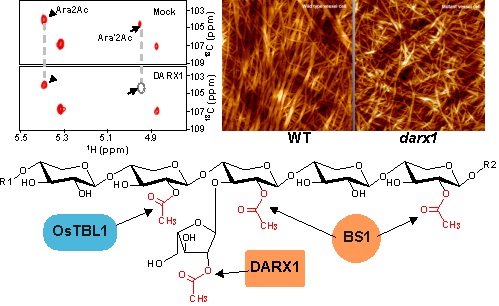Plant cells are encased in structurally diverse polymers, which are assembled into a fibrous network, forming the plant cell walls. Acetylation, a common modification of wall polymers, affects polymer properties and determines how these polymers interact. Increasing evidence revealed that acetylation profile on cell-wall polymers is tightly controlled, indicating a regulatory machinery to orchestrate cell-wall architecture and functions.
Arabinoxylan is an important hemicellulosic polysaccharide modified with a majority of acetyl esters. Furthermore, xylan interacts with cellulose and lignin, the other two cell-wall major polymers, via the two- and three-fold conformation that is modulated by the antagonism between acetylation and deacetylation according to plant-growth demands. Hence, comprehensive understanding of the mechanisms underpinning the control of xylan acetylation is crucial for elucidating cell-wall architecture and functions.
The group of Prof. ZHOU Yihua from the Institute of Genetics and Developmental Biology, Chinese Academy of Sciences, recently reported that rice DARX1 is a GDSL esterase that removes acetyl groups from excess acetylated arabinosyl substituents of arabinoxylan and modulates xylan conformation and microfibril orientation, thereby determining secondary wall architecture.
They identified a rice GDSL esterase DARX1 that deacetylates arabinoxylan side chains by screening acetyl esterases involved in arabinoxylan modification using enzymatic assays combined with protein mass spectrometry analysis. Mutations in DARX1 resulted in the accumulation of excess additional acetates on arabinosyl side chains of xylan, which could be abolished by recombinant DARX1 in vitro. Moreover, solid-state NMR spectroscopy and atomic force microscopy further revealed that the abnormal acetylation pattern of xylan in darx1 interrupts arabinoxylan conformation and cellulose microfibril orientation, resulting in compromised secondary wall patterning and reduced mechanical strength.
The finding in identifying an arabinosyl deacetylase, a new enzyme, provides an insight into how the arabinoxylan acetylation pattern, as well as its conformations, are established, which suggests a strategy to breed robust elite crops. Characterization of acetyl esterases, such as DARX1, open the door for understanding of the complicated relationship between polysaccharide acetylation profile and cell-wall structure, which is important for uncovering how functional cell walls are built.
This work was published online in
The Plant Cell entitled “Arabinosyl Deacetylase Modulates the Arabinoxylan Acetylation Profile and Secondary Wall Formation” with Dr. ZHANG Lanjun as the first author on March 18, 2019 (
DOI: 10.1105/tpc.18.00894). Drs. ZHANG Baocai and ZHOU Yihua are co-corresponding authors.
This research was supported by the National Natural Science Foundation of China, Youth Innovation Promotion Association CAS, and National Science Foundation of USA, as well as the State Key Laboratory of Plant Genomics.
Figure The Arabinosyl deacetylase DARX1 modulates xylan sidechain acetylation profile and cell wall architecture assembly in rice. (Image by IGDB)
Contact;
Mr. QI Lei
Institute of Genetics and Developmental Biology, Chinese Academy of Sciences
 Figure The Arabinosyl deacetylase DARX1 modulates xylan sidechain acetylation profile and cell wall architecture assembly in rice. (Image by IGDB)Contact;Mr. QI LeiInstitute of Genetics and Developmental Biology, Chinese Academy of SciencesEmail: lqi@genetics.ac.cn
Figure The Arabinosyl deacetylase DARX1 modulates xylan sidechain acetylation profile and cell wall architecture assembly in rice. (Image by IGDB)Contact;Mr. QI LeiInstitute of Genetics and Developmental Biology, Chinese Academy of SciencesEmail: lqi@genetics.ac.cn CAS
CAS
 中文
中文




.png)
